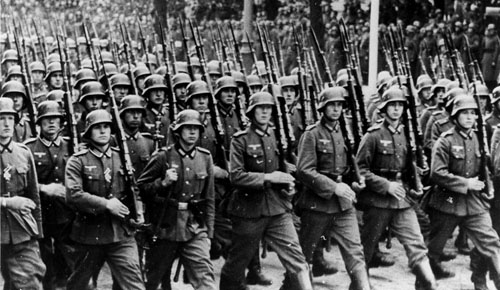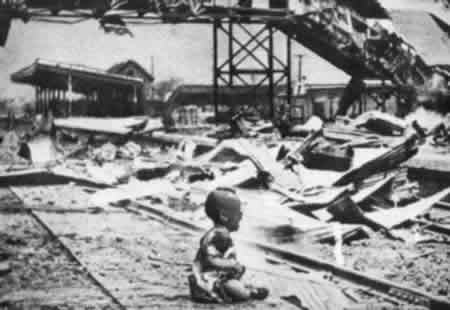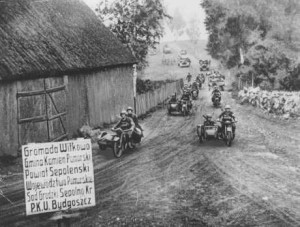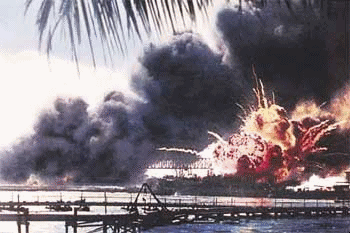
When Did World War Two Begin?
What Date Did World War Two Begin?
World War Two was the deadliest war in human history, and is arguably the war most written about and most discussed, both among historians and among the general population. So you would think that it would be simple to answer the question of “When did World War Two begin?”
But the question of when the Second World War began is not really that simple. By definition, it was a war that spanned the globe, and, like most wars both large and small, the reasons it began are complicated, and those many causes of World War Two developed over the course of decades.
Many traditional history textbooks place the start of World War Two at September 1, 1939, which is when Hitler’s Germany invaded their neighbor to east, Poland. But what about Asia? Over in East Asia, the Japanese and Chinese had been fighting for quite some time when Hitler invaded Poland. And how does the Spanish Civil War, which began in 1936, and ended only five months before the invasion of Poland, figure into this question?
Let us take a look at the historical evidence and see what we can find in a timeline of the wars and events leading to World War Two.
Japan at War
Japan began taking over chunks of China as early as 1931 (not counting the areas occupied and “given” to Japan as a result of their participation in World War One), with the invasion and annexation of the northern Chinese region of Manchuria. The Japanese Army began operations in Manchuria on September 18, 1931, which quickly established Japanese control of Manchuria. This was followed by local armed Chinese and Manchurian resistance to Japanese control, as well as a months-long battle in the southern Chinese city of Shanghai in 1932.
Many historians consider the Japanese invasion of Manchuria in 1931 as the start of World War Two. Despite this act of aggression, though, this did not create a true state of war between Japan and China. That would come in 1937, with the full-scale Japanese invasion of China and what is now referred to as the 2nd Sino-Japanese War.
If we consider the beginning of a major invasion and war in China as the start of the Second World War, than the date of July 7, 1937 is our start date.
War in Europe
But wait: What about Europe? After all, Hitler and Mussolini (and don’t forget about their sometime buddy Stalin), for a time conquered most of the continent of Europe (plus large chunks of North Africa) in their portion of World War Two.
Benito Mussolini took power in Italy in 1922, and Hitler became the leader of Germany in 1933. Both enjoyed dreams of conquest, with Mussolini trying to re-create a modern Roman Empire, and Hitler creating Germany’s Third Reich (or Third Empire or Third Realm, after the first two Reichs: The First Reich was the Holy Roman Empire, 962–1806, and the Second Reich was the German Empire of 1871–1918). Both of these goals required the invasion, subjugation, and/or destruction of other nations and peoples.
Hitler began the expansion of Germany more or less without making real war: in on March 7, 1936, he sent the German Army into the Rhineland, a part of western Germany that, by the Treaty of Versailles which ended World War One, was to remain a demilitarized zone. Hitler violated the treaty by sending in his army. Other than some weak diplomatic protests, the World War One Allies did nothing to stop him or punish Germany. Emboldened by the weak response of the Allies, Hitler continued expanding Germany. On March 12, 1938, the German Army entered Austria, thereby annexing the smaller German-speaking nation to Germany in what is referred to as the Anschluss (which in German means Annexation or Connection). Again, this annexation of Austria violated the treaties that had ended World War Two. And again, the Allies (Britain and France) did nothing to stop it.
Czech Crisis
Then came the Czechoslovakian Crisis when Hitler threatened war in order to annex the mostly German-speaking region of western Czechoslovakia known as the Sudetenland. With the signing of the Munich Pact on September 30, 1938, Britain and France agreed to let Germany take over the Sudeten area of Czechoslovakia. The Czechs, realizing they could not withstand a German invasion, surrendered that region without a fight. Hitler later violated the Munich Pact by annexing the rest of Czechoslovakia in March of 1939.
Mussolini’s Italy had also been busy re-creating an old empire. Italy invaded the Kingdom of Ethiopia (one of only two independent African nations at that time) in 1935. The Ethiopians put up a strong resistance, but fell to the Italian invaders by May of 1936. Mussolini also invaded the European Balkan nation of Albania in April, 1939.
Spanish Civil War
But if we are looking for an actual fighting war in Europe to serve as the start of the European war, we could easily consider the Spanish Civil War as the place to start. Begun on July 17, 1936 by an attempt by Fascist elements of the Spanish Army to take over power from the Republican government of Spain, the war enveloped the whole of Spain and drew in other notable powers. Both Germany and Italy sent troops and warplanes to aid the Nationalist side (as General Franco’s Fascist forces referred to themselves), while the Soviet Union sent aid to the Republican forces. Volunteers from the U.S, Britain, France, and other nations joined the fight on the Republican side. In an early mirror image of the later fighting in Europe in World War Two, we see an uneasy alliance of democratic forces and leftist, pro-Soviet forces fighting against the Fascist/Nationalist forces of Franco, Hitler, and Mussolini.
It is reasonable to say that the Asian portion of World War Two began in either 1931 or 1937, with the Japanese attacks on China (we lean toward 1937, as that is when the major invasion of, and the war on, China began). It is also reasonable to say that the European portion of World War Two began in either 1936 (Spanish Civil War start), or the German invasion of Poland in 1939. Again, we lean strongly toward the September 1, 1939 invasion of Poland, as that began the war between Germany and the Allies (Britain, France, Canada, Australia, New Zealand, South Africa, and of course, Poland), and it also ties in the Soviet Union as an aggressor (the Soviets joined in the German invasion of Poland and also invaded Finland, among others).
The question of when did World War Two really begin?
We now come to our question of when did World War Two really begin? Despite the fact that Germany, Italy, and Japan joined in an alliance called the Anti-Comintern Pact (created by Germany and Japan in 1936, with Italy joining in 1937) that would eventually cause them to be called the “Axis Powers,” the two European Axis powers were not joined in war by Japan against common foes until December, 1941, when Japan launched surprise attacks on not only the neutral United States (Pearl Harbor), but also on British, French, and Dutch (all Allies in the European war), thereby turning two marginally related regional wars into one gigantic Second World War.
What do you think of our analysis and answer to the question of when World War Two really began? Share your thoughts in our comments section below and/or share over social media.




I’ve always thought that the invasion of Poland as the start date of WWII a conceit by Europeans. I had a disagreement on a online forum in which a European member insisted that the war began in September 1939. I mentioned that the Chinese were already fighting the Japanese invasion but that didn’t phase his apparently beloved and cherished opinion that the war officially started in Europe. I suppose one could argue that was in fact the date the war went global or World War.